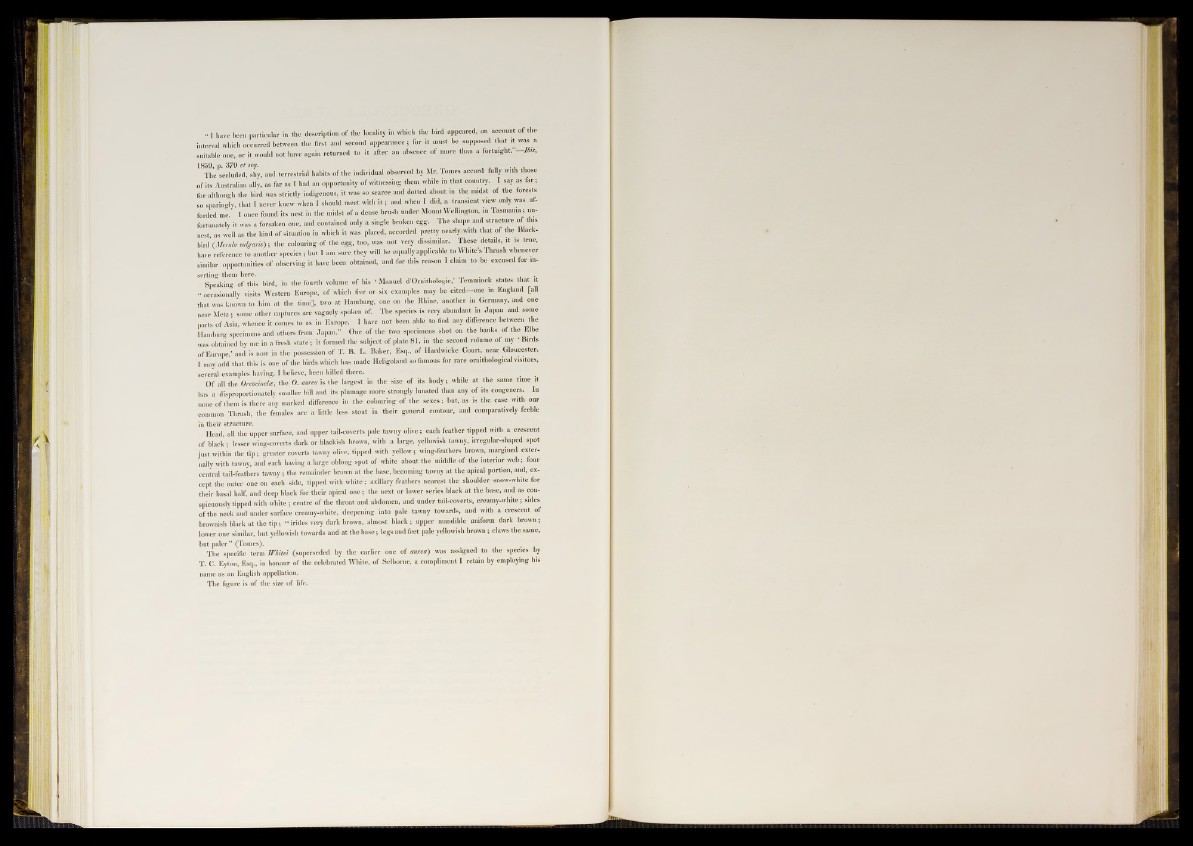
1 1 have been particular in the description of the locality in which the bird appeared, on account of the
interval which occurred between the first and second appearance; for it must be supposed that it was a
suitable one, or it would not have again returned to it after an absence o f more than a fortnight.”—Ih s,
1859, p. 379 e t seq. .
The secluded, shy, and terrestrial habits of the individual observed by Mr. Tomes accord fully with those
of its Australian ally, as far as I had an opportunity of witnessing them while in that country. I say as far ;
for although the bird was strictly indigenous, it was so scarce and dotted about in the midst of the forests
so sparingly, that I never knew when I should meet with i t ; and when I did, a transient view only was afforded
me. I once found its nest in the midst of a dense brush under Mount Wellington, in Tasmania; unfortunately
it was a forsaken oue, and contained only a single broken egg. The shape and structure o f this
nest, as well as the kind of situation in which it was placed, accorded pretty nearly with that of the Blackbird’
(Merula wtgam)-, the colouring of the egg, too, was not very dissimilar. These details, it is true,
have reference to another species; but I am sure they will be equally applicable to White’s Thrush whenever
similar opportunities of observing it have been obtained, and for this reason I claim to be excused for inserting
them here. .
Speaking of this bird, in the fourth volume of his ‘ Manuel d’Ornithologie,’ Temmmck states that it
“ occasionally visits Western Europe, of which live or six examples may be cited—one in England [all
that was known to him a t the time], two at Hamburg, one on the Rhine, another in Germany, and one
near Mete; some other captures are vaguely spoken of. The species is very abundant in Japan and some
parts of Asia, whence it comes to us in Europe. I have not been able to find any difference between the
Hamburg specimens and others from Japan." One of the two specimens shot on the banks o f the Elbe
was obtained by me in a fresh s ta te ; it formed the subject of plate 81, in the second volume of my ‘ Birds
of Europe,’ and is now in the possession of T. B. L. Baker, Esq., of Hardwicke Court, near Gloucester.
I may add that this is one of the birds which has made Heligoland so famous for rare ornithological visitors,
several examples having, I believe, been killed there.
Of all the Oreoctnclte, the 0 . aurea is the largest in the size of its body; while a t the same time it
has a disproportionately smaller bill aud its plumage more strongly lunated than any of its congeners. Iu
none of them is there any marked difference in the colouring of the sexes; hut, as is the case with our
common Thrush, the females are a little less stout iu their general contour, and comparatively feeble
in their structure.
Head, all the upper surface, and upper tail-coverts pale tawny olive; each feather tipped with a crescent
of black; lesser wing-coverts dark or blackish brown, with a large, yellowish tawny, irregular-shaped spot
ju st within the t ip ; greater coverts tawny olive, tipped with yellow; wiug-feathers brown, margined exter-j
nally with tawny, and each having a large oblong spot of white about the middle of the interior web; four
central tail-feathers tawny; the remainder brown a t the base, becoming tawny at the apical portion, and, except
the outer one on each side, tipped with white; axillary feathers nearest the shoulder snow-white for
their basal half, and deep black for their apical o n e ; the next or lower series black at the base, and as conspicuously
tipped with white ; centre of the throat and abdomen, and under tail-coverts, creamy-white; sides
o f the neck and under surface creamy-white, deepening into pale tawny towards, and with a crescent of
brownish black at the t ip ; “ ¡rides very dark brown, almost black ; upper mandible uniform dark brown;
lower one similar, but yellowish towards and a t the b a se; legs and feet pale yellowish brown; claws the same,
but paler ” (Tomes).
The specific term Whitei (superseded by the earlier one o f aurea) was assigned to the species by
T . C. Eyton, Esq., in honour of the celebrated White, of Selborne, a compliment I retain by employing his
name as an English appellation.
The figure is of the size of life.